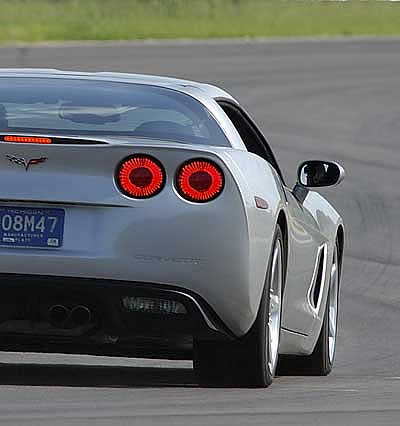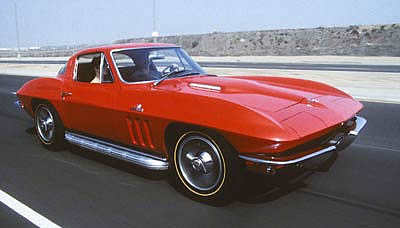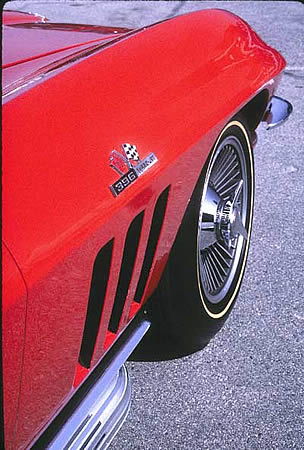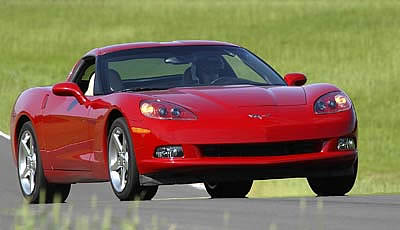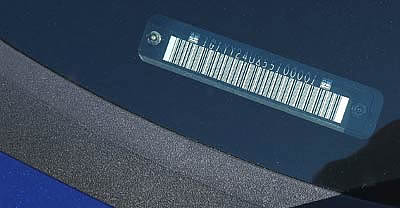C6, Naked and Exposed: Corvette Action Center's First Look at the 2005 Corvette - The Sequel: Finally, We Drive It! - Page 3 of 12
 |
 |
C6 Naked and Exposed - The Sequel: Finally...We Drive It!!! - Page 3 of 12
And, Talk to Some of the People who Built It
by Hib Halverson
Imagery by GM Communications, Richard Prince, U.S. Air Force and Sharkcom
©2005 Shark Communications
No use without permission
TP: We weren't working in a vacuum either, that is: it wasn't just what we thought the race cars should have or were using. We had actual experience. We had Pratt and Miller (the business which operates the GTS-class, C5-R road race effort) and Doug Fehan's group from Corvette Racing help us work on the head light. We took into consideration Corvette's race heritage and the C5-R's current race configuration, ie: the center-port grille opening relative to the headlamps.
Historically, in some areas, Corvette has been influenced by Ferrari; not so much to copy, but for inspiration. The big round taillights? I'd venture they were looking at some Ferraris. I know that for C4 and C5, they were looking at Ferrari. Yes, we did look at the Ferrari headlamps because they're body color. I felt it was important to have body color in there because it keeps the continuity of the fender lines going through the lamp area and helps differentiate from other cars. We went back and forth. We had a lot of discussion with the (Corvette) Brand Team (at Chevrolet) on what they were nervous about. We did market evaluations which came out, like 50/50. Even internally, it was kind of 50/50. But, at the Design Management level, support for the fixed lamps was virtually unanamous.
As we developed the lamps, I always kept the car's overall look in mind. I felt that if you could look at the overall vehicle and what you saw still said in a very powerful way, "Corvette", then the fixed lights would be sucessful.
CAC: In the end, it was a a 50/50 split in clinics, 50/50 split between GM internals, with Design Management, meaning...
TP: ...Jerry (Palmer, now retired), Wayne (Cherry, GM VP of Design) and myself...
CAC: All supporting the fixed lights?
TP: Yeah.
So, I made the final decision and, at this point, no question, it was the right one. The response has been overwhelmingly positive. Some people were leery at first until they saw the whole car. Now, all of them are supporters.
CAC: Why did C6 need to have a stronger influence by past Corvette exteriors?
TP: There's so much competition; so many choices, but the cars that become memorable are ones to which people develop the most emotional connection. There are certain vehicles which do this better because they have a history; there's a deeper, richer sense of soul to them which influences the customer's passion.
I think, uh...digging deep and taking advantage of our car's history, but not in a retro way, makes the car more substantive; makes it more timeless and serves to prove-out a design philosophy that is long-lasting.
Corvette is something with a deeper sense of substance to it and that makes it a greater, more significant statement. That significance comes from being a simple statement but, also, a very powerful one. By simple, I don't mean 'unsophisticated.' When you look at C2 or C3, the overall impact is very simple and powerful, but, take the fender shapes; very straight forward, but upon closer inspection, one's visual sense is delighted by the complex surface transistions.
Actually, that goes back to the F/A-22 thing. The (Raptor's) overall statement's pretty aggressive, pretty angular, pretty bold, pretty simple, but when you get in deeper; you see these sophisticated sculptural forms and surface transisions that are very interesting, intriguing and exciting.
Corvette is not like a Toyota Celica or a Mazda RX8 or whatever. Hey, not everybody can do Corvettes. To me, that's what makes something truly art, truly special and truly significant. These truly timeless designs aren't easily accomplished.
It took a balanced team of designers to do this car. We hand-picked several who had not worked on Corvette before, but in reviewing their sketches and work on other programs; I saw they had that 'Corvette touch.' They brought a fresh approach to Corvette design with a variety of different perspectives and, since they'd worked on other programs, they brought experience, too.
Eric Clough was the Lead Interior Designer. He's a super talent; one of those guys who can do it all. He had a lot of interior experience with computers. While we usually have 3D math sculptors who will build surfaces, he can do it himself. He's part of a trend in designers who can not only draw on the computer, but can also build the surface on the computer. Another interior designer who had a key role on C6 was Matt Erdey. Working for Eric, he sketched the theme we eventually translated into the car. Matt is an avid Corvette guy. He has a really cool, tricked-out, '99 which is just a monster on the street. A real hands on guy, one time he was telling me he needed bigger wheels and tires on the back of his car, so he tubbed it in a weekend.
One of my frustrations is that, as a design executive, I don't get to draw as much. I did a few pencil sketches and a scale model but, for the most part, I depended on my team for a lot of the hot design stuff in a lot of our sketches. Some were Kirk's and others were done by Sang Yup Lee, another Staff Designer. He contributed much to the base car and a lot of what you'll see on the (C6) Z06. Kalvin Tanner is another young designer helped give the C6 its fresh perspective of the Corvette mystique. I talked earlier about sculptors. We'd have been nowhere without good ones and some of the best worked on C6; Mark Kidd, Joe Klomp and Chris Knack.
I told this team, 'Look at the C2 and the C3. Study the designs and identify those elements which really make it Corvette; which really make it powerful; which really capture the mystique of America's Sports Car. What are the elements of that spirit? You know, the fender shapes, how the uppers work in overall proportion. Let's distill that and reinterpret ii in a fresh way, but maintain elements of the C2's spirit.'
I felt it was right to do that for this vehicle at this time because the Corvette has such a rich history. I think the customer is both sensitive to it and appreciates it.
CAC: Tell us one design element that didn't make production which you would have liked to have had.
TP: Hmmm. That's a tough one. I think, um...let me think about this a second.
While Peters took a moment, I noted that it was a beautiful late-Spring morning. For some time we'd been on back roads in a part of rural Michigan bound by Ann Arbor, Lansing and Battle Creek. An all-new Vette is big news in America. One thing I really wanted to see, but couldn't because of it being a weekday, was the reaction of Joe Average as we passed through small towns. In fact, had we seen a group of people, I was planning to stop and get some of person-on-the-street opinions, but the opportunity didn't present itself.
Since my C6 drive on June 4th, now that some Corvette owners have seen C6s at events such as our own Corvette Action Center "Cruisefest", the "C5 Birthday Bash" and "Corvettes at Carlisle", it seems that Joe Average; at least the members of the Average family who are interested in Corvettes, like what Tom Peters and his Team did with the outside of the new car.
Finally, Tom Peters said, "I think I'd have bigger wheels and tires. Also, I wish we had a little more flexibility in the upper configuration because, when you have a targa top and convertible, those kind of lock you in somewhat in terms of what your design options are. I wish we had a little more freedom, there, but I think what we came-up with works extremely well."
CAC: You remember that rumor that Bob Lutz (GM Vice Chairman for Product Development and Chairman of GM North America) did not like C6?
TP: Yeah.
CAC: I never believed that because, when that rumor hit, it was too late in the program for a major change to occur but, for the record, how did that get started?
TP: Soon after (Lutz) came aboard (Sept. 2001), he reviewed all the programs and Corvette was one of them. It was at Design North (a remote design facility at the sprawling GM Tech Center in Warren, Michigan) out on the patio. Dave Hill, Jerry Palmer and myself were there. He came out, said he liked the car. Basically it was pretty much done and off he went. He was very positive. He was not critical at all. He told us to 'stay the course' and proceed full speed ahead.
Word got out that the program was delayed six months, but the reason was totally unrelated to that (Lutz's opinion on Corvette). From what I understand, it was a business decision. The company decided to let some programs slide for six-months. You might want to ask Dave to confirm that.
We did just that and, while we have an interview with Vehicle Line Executive, Dave Hill coming later in the Corvette Action Center's expanded C6 coverage, here's what, Hill told us about this particular issue, "There was a re-timing of the original C6 program. That happened in December 2001. The economic shock of 9/11 and the high cost of sales caused GM to revisit a number of program schedules. Changes were made to adjust to the new world. Both schedules and program contents were adjusted."
"Our program," Dave continued, "with its very good sales and quality success, was deemed possible to suffer a re-timing. That is how we became a 2005 model. So it was business and economics, not styling."
TP: My understanding was it was slid by the Corporation for business reasons, not because someone said, 'Well, Bob came in and didn't like the car and you guys need to change the theme.' We didn't change anything major at all.
Needless to say, we took advantage of the extra time to continue the refinement of everything; whether it was design, engineering, quality or whatever; we utilized that time wisely.
CAC: Let's talk about colors for a minute. Both Daytona Sunset Orange and Precision Red are new for '05. My understanding is that the Precision Red has already been discontinued.
TP: Mmm...no. Um, that's probably one thing that Bob had some input on. There was a lot of discussion and concern about that red. (Chevrolet) is going to transition to a brighter red, but that one's (Precision Red) gonna run for the first few months.
CAC: In other words, it's going to run part of '05?
TP: I think it may run all of '05, but I don't know for sure where they've ended-up with that.
I've gotta tell you, I'm a little frustrated about that because, from a design standpoint, we think it's the right red. We heard there was negative feedback because (Chevrolet) didn't have the Torch Red. When we were in color selection for this vehicle, there was Torch Red and several other reds and in them was this 'Cobalt Red', ah...'Precision Red.'
CAC: You guys called it "Cobalt Red" inside, but outside it was "Precision Red"?
TP: Yeah. We give the colors development code names, initially, then they (persons other than designers) pick official names for them.
At any rate, I was involved in those discussions. It wasn't like we had a whole spectrum of reds. We had a limited set. I felt Cobalt Red was really good for two reasons: 1) I wanted to do everything in my power to select colors which emphasized the surface and the form of this vehicle. We painted some samples of Torch Red and it just went flat. We couldn't see the reflection patterns that describe the form and it made the surface development less obvious and even obscured it in some situations. The alternate red they've selected is a huge improvement over Torch Red in that respect. It's midway between Cobalt and Torch. 2) I thought the Cobalt Red was more contemporary, and international; not that we were trying to design a European sports car, but it had, in my opinion, a more global appeal.
CAC: Of all the C6 colors, what's your favorite?
TP: That's tough...I think I'd buy the silver with the bright wheels. It looks like a jet fighter. Reminds me of that F/A-22. I like the Cobalt Red and I'm anxious to see a black one all tricked-out, because I've not seen black on a car, yet, but if I were to buy one today; it'd probably be silver, bright wheels and the Z51 suspension.
On the map, here, I see we're almost to the car change by the lake.
CAC: Ok. My last question: how old were you when you became interested in Vettes?
TP: Everybody remembers their first ride in a Corvette. I was probably 12. It had to have been about 1968 or '69. I used to caddy and I'd hitchhike to and from the golf course. I was coming home one day and a Corvette comes down the road. In my mind, Corvettes were always the pinnacle. When I was hitchhiking, the reason I knew that car was a Vette and that it was a cool car was because I used to draw them all the time and look at them in the hot rod magazines.
I'm sticking my thumb out and thinking, 'that guy is never gonna pick me up'. So I turned around but the guy pulled in behind me and said, 'Hop in.' I couldn't believe it! My first ride in a Corvette! It's like an alien space ship landed and the guy's going to give you a ride. To this day, I remember that. I thought I was on top of the world. I don't remember the color but I remember it was a Corvette. I remember the fenders and I remember sitting in there and looking out over the hood. As a kid you sit real low, you see these big fenders sticking up, you know? And you hear the motor, (makes an engine noise), and you're in that tight little cockpit. It was awesome!
I remember the guy dropped me off and I had a ways to go, 'because he was going' the other way. I walked all the way home with my head in the clouds.
To check facts and ask some more questions, we did a second, follow-up interview by phone with Tom Peters a few weeks before this article was posted. We asked him some additional, member-submitted questions and carried-on a lengthy discussion of C6 aerodynamics. To read that follow-up, click here.
The first segment of the ride ended at a delightful picnic area next to Portage Lake about 4-mi. east of a village called (I'm not making this up) "Hell, Michigan"; no doubt where engineers and marketing weenies who worked on the Ford's GT and Chrysler's Viper are going to think they are once Chevrolet introduces the new Z06 at the Detroit Auto Show next January.
Oh, did I mention the '05 Tom Peters and I were in was VIN 00001? The first production C6 built. It's a LeMans Blue targa with Cashmere interior, a six-speed and polished wheels. It will be retained by GM in its collection of historical cars. It was the first time I've driven Serial Number One of anything. Some were surprised GM put that car in the hands of some of the crazed media (this humble scribe excepted, of course) who sometimes attend such events.
After getting out of VIN One, I hung-out, looking at it up close and touching the car while pondering some of what Peters and I had been talking about for the last hour. Then, I stood off to the side, about 50 feet out and considered the F/A-22 issue. In my earlier story (C6, Naked and Exposed: Corvette Action Center's First Look at the 2005 Corvette) I said, "The Raptor's rounded, 'stealth technology' surfaces can be sensed in an abstract sort of way." Well...I thought, as I gazed at this '05, no doubt, C6 has both sharp edges, complex sculpted shapes and, yeah, the transitions between a lot of them are visually, interesting and delightful. There's more Raptor there than I thought.
 |
 |
